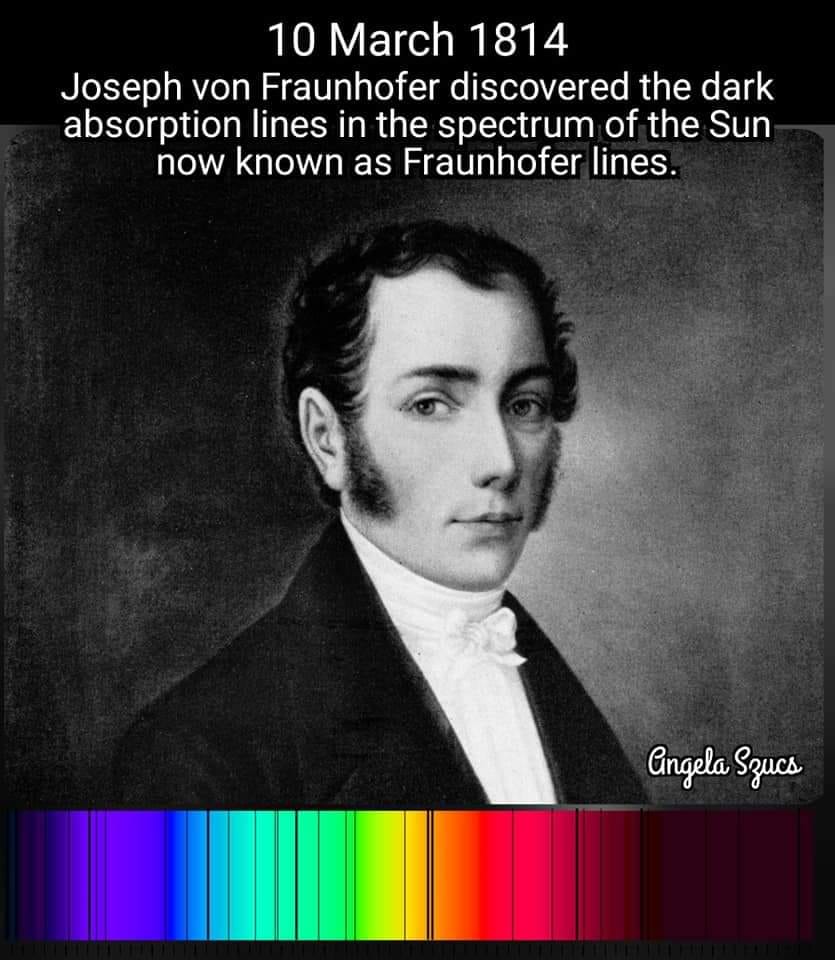
Joseph von Fraunhofer
(6 March 1787 – 7 June 1826) ![]() German physicist and optical lens manufacturer.
German physicist and optical lens manufacturer.
![]() He made optical glass and achromatic telescope objective lenses, invented the spectroscope, and developed diffraction grating.
He made optical glass and achromatic telescope objective lenses, invented the spectroscope, and developed diffraction grating.
Joseph von Fraunhofer (Straubing, 6 maart 1787 – München, 7 juni 1826) was een Duits natuur- en werktuigkundige. Zijn grootste bekendheid heeft hij te danken aan zijn onderzoek van vaste absorptielijnen in het zonnespectrum, die naar hem ook wel fraunhoferlijnen worden genoemd. Voorts onderscheidde hij zich in de bouw van optische instrumenten en de fabricage van optisch glas. Hij is de uitvinder van de zogenaamde Duitse montering voor telescopen. Het Fraunhofer-Gesellschaft is naar hem vernoemd.
Leven en werk
Joseph Fraunhofer werd op jonge leeftijd ontdekt door Joseph von Utzschneider, die aan het hoofd stond van het Mathematisch-Mechanische Institut te München, een fabriek van optische instrumenten. Hij onderkende de uitzonderlijke begaafdheid van de jongen en zorgde ervoor dat hij zich in de wis- en natuurkunde bekwaamde. In 1806, hij was toen 19 jaar, gaf Utzschneider hem de leiding over de glasfabriek van het instituut, op het terrein van een voormalig klooster in Benediktbeuern ten zuiden van München. Daar leerde hij van de Zwitser Pierre-Louis Guinand een methode om zeer homogeen flintglas te maken, een materiaal dat onontbeerlijk was voor de fabricage van achromatische lenzen. Hij ontwikkelde zich verder tot een bedreven lenzenslijper met een grote kennis van de optica en hij was een begaafd en vindingrijk werktuigbouwkundige. In 1819 voltooide hij zijn meesterwerk, een objectief met een opening van 244 mm voor de Russische sterrenwacht in Dorpat (nu Tartu, Estland). De met dit objectief gebouwde telescoop steunde op een nieuwe uitvinding van hem: een statief met een zogenaamde Duitse montering. Het instrument bestaat nog steeds en werd in 1993 gerestaureerd. Hij bouwde ook de heliometer waarmee Friedrich Bessel voor het eerst de parallax van (en daarmee de afstand tot) de ster 61 Cygni mat.
In 1813 ontdekte Fraunhofer de naar hem genoemde fraunhoferlijnen in het zonnespectrum. Die waren reeds in 1802 ontdekt door de Engelse arts en scheikundige William Hyde Wollaston, maar die had ten onrechte aangenomen dat de lijnen afscheidingen waren tussen de verschillende kleuren. In 1814 vond hij de spectroscoop uit, die hij daarna steeds verder ontwikkelde, tot en met het gebruik van een buigingsrooster toe. De kennis die hij zo verzamelde benutte hij onder andere voor het maken van steeds betere objectieven.
Fraunhofer werd tot lid van de Bayerische Akademie der Wissenschaften benoemd en tot Ritter des bayerischen Civilverdienstordens geslagen, waarmee hij in de adelstand werd verheven en zich voortaan “von Fraunhofer” mocht noemen. In 1825 werd hij ziek en het jaar daarop stierf hij, op 39-jarige leeftijd, aan longtuberculose. Hij kreeg een staatsbegrafenis en werd bijgezet op het Südfriedhof te München. https://nl.wikipedia.org/wiki/Joseph_von_Fraunhofer
A Decade of Unveiling the Hidden Universe: ALMA at 10
Newswise — On March 13th, 2023, astronomers around the world will mark the 10th anniversary of the inauguration of the Atacama Large Millimeter/submillimeter Array (ALMA), the world’s largest radio telescope. Over the past decade, the international ALMA collaboration— led by the U.S. National Science Foundation’s National Radio Astronomy Observatory (NRAO), the European Southern Observatory (ESO), and the National Astronomical Observatory of Japan (NAOJ)— has revolutionized our understanding of the Universe and unveiled its secrets, from the formation of planets, stars, and galaxies to deciphering the chemistry of the cosmos, and even taking part in capturing the first images of black holes.
ALMA’s decade of success was preceded by Early Science Observations in 2011, nearly a full two years before the telescope was inaugurated. This test period for ALMA yielded complex and beautiful images which revealed star formation and violent galaxy mergers in the Antennae Galaxies at a level of detail no other telescopes on Earth had ever attained. These pre-inaugural observations allowed ALMA to grow into what it is today.
“Since its first light, ALMA has not only changed our understanding of the Universe, but also the way in which we look at it,” said Tony Beasley, Director of NRAO and AUI Vice President for radio astronomy. “In order to look deeper into the Universe and to see things that no other telescopes can see with such clarity, like water hiding out in the disks of young stars, and the supermassive black hole in the heart of the Milky Way, we have continuously developed cutting-edge technology, including some of the fastest supercomputing processors in the world.”
ALMA consists of 66 antennas, spread over up to 16 kilometers— nearly 10 miles— on the Chajnantor Plateau of the Chilean Andes at 5,000 meters— or 16,404 feet— above sea level. The technology that makes the telescope special is borne of an international collaboration of 21 countries from across North America, Europe, and East Asia. NRAO’s Central Development Laboratory (CDL) is responsible for the development of the Band 6 receiver, ALMA’s most scientifically productive receiver, which was approved for upgrades in 2021. ALMA was also approved earlier this year for the development of a new central correlator and digital transmission system, upgrades that will eventually increase the system bandwidth by a factor of four, and that will be carried out by NRAO and several other partners. This technology, and other innovations like it, have supported ALMA-user scientists to produce more than 3,000 scientific publications to date. That’s nearly one publication per day for a decade.
“ALMA has captured the world’s imagination since it unveiled its first images more than a decade ago, and it has opened new windows on the Universe that could not have been opened otherwise,” said Karen Marrongelle, U.S. National Science Foundation Chief Operating Officer. “Our commitment to ALMA now and for the future is the same as it was then: to develop the technology that unlocks and expands our knowledge of the Milky Way and every other galaxy in our Universe.”
Among ALMA’s most notable contributions are the first clear pictures of planet formation, observed around the young star HL Tau by scientists from ALMA’s partner regions and led by NRAO in 2014, and supermassive black holes M87*and SgrA*, observed by the Event Horizon Telescope (EHT) collaboration in 2019 and 2022, respectively.
“ALMA has transformed our understanding of the Universe and opened new research frontiers,” said Sean Dougherty, Director of ALMA. “We are very proud of the accomplishments of the past decade and excited about the discoveries over the next ten years.”
About NRAO
The National Radio Astronomy Observatory (NRAO) is a facility of the National Science Foundation, operated under cooperative agreement by Associated Universities, Inc.
About ALMA
The Atacama Large Millimeter/submillimeter Array (ALMA), an international astronomy facility, is a partnership of the European Organisation for Astronomical Research in the Southern Hemisphere (ESO), the U.S. National Science Foundation (NSF) and the National Institutes of Natural Sciences (NINS) of Japan in cooperation with the Republic of Chile. ALMA is funded by ESO on behalf of its Member States, by NSF in cooperation with the National Research Council of Canada (NRC) and the Ministry of Science and Technology (MOST) and by NINS in cooperation with the Academia Sinica (AS) in Taiwan and the Korea Astronomy and Space Science Institute (KASI).
ALMA construction and operations are led by ESO on behalf of its Member States; by the National Radio Astronomy Observatory (NRAO), managed by Associated Universities, Inc. (AUI), on behalf of North America; and by the National Astronomical Observatory of Japan (NAOJ) on behalf of East Asia. The Joint ALMA Observatory (JAO) provides the unified leadership and management of the construction, commissioning and operation of ALMA. https://www.newswise.com/articles/a-decade-of-unveiling-the-hidden-universe-alma-at-10?fbclid=IwAR0W8yfQKSrL5y5yCRmfFzc8N-9ONjH3hDW31s-mtFWOa6XkVYo7uenwz5k



